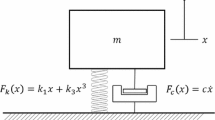Abstract
This paper provides a first indication that this is true for a system comprised of a static structure described by hyperbolic partial differential equations and is subjected to an external random input force. The system deforms the randomness of an input force sequence in proportion to its algorithmic complexity. The authors demonstrate this by numerical analysis of a one-dimensional vibrating elastic solid (the system) on which we apply a maximally-random force sequence (input). The level of complexity of the system is controlled via external parameters. The output response is the field of displacements observed at several positions on the body. The algorithmic complexity and stochasticity of the resulting output displacement sequence is measured and compared against the complexity of the system. The results show that the higher the system complexity, the more random-deficient the output sequence.
Similar content being viewed by others
References
G. J. Chaitin, A theory of program size formally identical to information theory, Journal of the ACM, 1975, 22(3): 329–340.
A. V. Deshmukh, J. Talavage, and M. Barash, Complexity in manufacturing systems, part 1: Analysis of static complexity, IIE Transactions, 1998, 30(7): 645–655.
V. V. Vyugin, Algorithmic complexity and stochastic properties of finite binary sequences, The Computer Journal, 1999, 42: 294–317.
J. Ratsaby, An algorithmic complexity interpretation of Lin’s third law of information theory, Entropy, 2008, 10(1): 6–14.
J. Ratsaby, On the randomness in learning, Proc. of 7th IEEE International Conference on Computational Cybernetics, (ICCC’09), 2009: 141–145.
J. Ratsaby, On the sysratio and its critical point, Mathematical and Computer Modelling, 2010.
J. Ratsaby, Some consequences of the complexity of intelligent prediction, Broad Research in Artificial Intelligence and Neuroscience, 2010, 1(3): 113–118.
J. Ratsaby, On the relation between a system’s complexity and its interaction with random environments, Proceedings of International symposium on stochastic models in reliability engineering, life sciences and operations management (SMRLO’10), 2010: 893–901.
J. Ratsaby, An empirical study of the complexity and randomness of prediction error sequences, Communications in Nonlinear Science and Numerical Simulation, in Press, 2010.
J. Ratsaby and I. Chaskalovic, Random patterns and complexity in static structures, Proc. of International Conference on Artificial Intelligence and Pattern Recognition (AIPR’09), Mathematics and Computer Science, 2009: 255–261.
M. Sipser, Introduction to the Theory of Computation, Course Technology, 1997.
J. C. Shepherdson and H. E. Sturgis, Computability of recursive functions, Journal of the Association of Computing Machinery, 1963, 10: 217–255.
A. Church, A set of postulates for the foundation of logic, Annals of Mathematics, 1932, 33: 346–366.
S. C. Kleene, Introduction to Metamathematics, North-Holland, Amsterdam, 1952.
A. N. Kolmogorov, Three approaches to the quantitative definition of information, Problems of Information Transmission, 1965, 1: 1–17.
A. N. Kolmogorov, On tables of random numbers, Theoretical Computer Science, 1998, 207(2): 387–395.
A. E. Asarin, Some properties of Kolmogorov δ random finite sequences, SIAM Theory of Probability and its Applications, 1987, 32: 507–508.
A. E. Asarin, On some properties of finite objects random in an algorithmic sense, Soviet Mathematics Doklady, 1988, 36(1): 109–112.
J. Ziv and A. Lempel, A universal algorithm for sequential data compression, IEEE Transactions on Information Theory, 1977, 23(3): 337–343.
J. Ratsaby, Prediction by compression, Proc. of the Eighth IASTED International Conference on Signal Processing, Pattern Recognition and Applications (SPPRA’11), 2011.
Author information
Authors and Affiliations
Corresponding author
Rights and permissions
About this article
Cite this article
Ratsaby, J., Chaskalovic, J. On the algorithmic complexity of static structures. J Syst Sci Complex 23, 1037–1053 (2010). https://doi.org/10.1007/s11424-010-8465-2
Received:
Revised:
Published:
Issue Date:
DOI: https://doi.org/10.1007/s11424-010-8465-2




